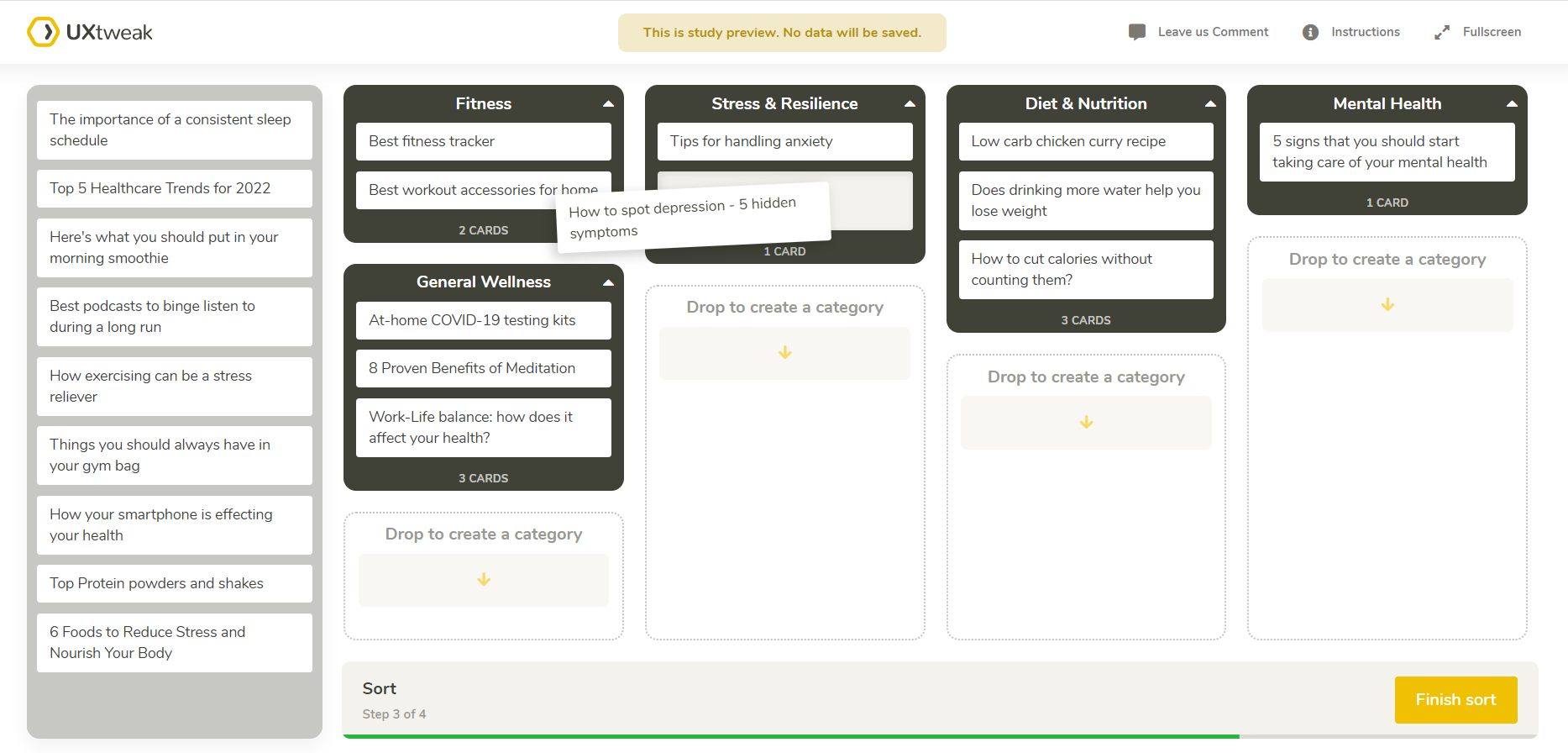Evaluation research is an essential part of creating any type of digital product that is meant for the users. But how to approach the whole evaluation study process and choose the right one among all the evaluation research methods?
In this chapter we explain it all, but first, let’s define what evaluation research is and why you need it in your project.
Evaluation research: Definition
Evaluation research, also known as evaluative research, is a type of research used to determine a product’s usefulness as well as its consumer appeal and suitability.
In simple terms, with the help of evaluation research methods you can assess how user friendly and helpful your product is, get direct design feedback from your end users and uncover hidden usability issues.
Learn more about evaluation research.
Types of evaluation research methods

Evaluation research methods come in all shapes and sizes, helping you get both qualitative and quantitative insights on your project. UX researchers use them to make informed design decisions along the product development process and assess how well it caters to the target audience’s needs.
As mentioned above, there are quantitative and qualitative evaluation research methods. Below, we’ll take a look at what makes them different and look closer to each of the approaches.
Qualitative evaluation research methods
These are the research methods that help you gather deeper insights into how users interact with the product, what problems they encounter, as well as evaluate the overall user experience and usability.
In evaluation research qualitative methods include:
- Usability testing
- Prototype testing
- Task analysis
Quantitative evaluation research methods
These are the methods that help you gather statistical data about your users’ behavior and preferences. Quantitative research studies usually require a higher number of respondents than qualitative ones in order to deliver accurate results and relevant numbers.
Some of the quantitative evaluation research methods include:
- Card sorting
- Tree testing
- First click testing
- Preference testing
- Surveys
Evaluation research methods
Let’s take a look at each of the methods and how they can help you to evaluate the quality and user experience of your product.
Usability Testing
Usability testing is a process of testing your product with real users by giving them tasks to perform and watching them interact with it. It’s especially useful in a context of evaluation research as it allows you to define the full scope of potential problems that need to be fixed and provides real insight on whether or not your product appeals to the user.
You can choose between running a moderated or an unmoderated study, depending on your goals, time and budget. Usability testing is a method accessible to anyone and it usually doesn’t require more than 5 participants in one study.
With the help of an online usability testing tool like UXtweak you can easily set up a study in minutes, send it out to the participants and see what usability issues they encounter!
We have a whole Usability Testing Guide where we explain all the aspects of the method, its benefits and share some of the tools you can use to perform the study.
And if you’re too busy to read, check out this quick video which explains how usability testing works:
Prototype Testing
Prototype testing is essentially the easiest way to eliminate usability issues from your designs at the early stages of the development. This evaluative research method can help you save tons of resources on later redesign and make sure you launch an already user-friendly product that users love.
It works just like usability testing, except instead of a finished website, you’re testing a design prototype, which should not even be at its final stage yet. Running Figma user testing can help to fine-tune any imperfections of your designs, add missing features and get rid of the useless ones. It’s also a great way to generate new ideas and get to know your users’ needs better.
All you need to do to perform such a test is choose one of the prototype testing tools available online and share a link to your design. It’s that simple!
See how UXtweak’s Prototype testing tool works in these demos:
Task Analysis
Task analysis is a method used in UX research to better understand how users approach their tasks with your product. It involves breaking down a specific task into smaller steps in order to put yourself into the users’ shoes and fine-tune the user flow for better experience.
Some task analysis methods include experience mapping, user journey mapping, UX storyboarding and others. They help to evaluate how easy it is for the user to achieve their goals with the product, uncover the roadblocks they encounter and just better empathize with the user.
This, in its turn, leads you to uncover new ideas for product improvement and better user experience.
Learn more about Task Analysis and How to Perform It.
Closed Card Sorting
Card sorting is a user research technique that helps teams to find out how users experience product’s content to be organized. The method itself is based on giving participants a set of cards and asking to sort them into specific categories.
For evaluation research, we recommend closed card sorting, which implies that users already have the names of each category defined and just need to sort the cards into the ones they perceive to be most relevant. This is a great way to evaluate the effectiveness of your product’s navigation, see how users expect the content to be structured and uncover where you need to make changes.
To perform card sorting all you need is a card sorting tool and a bunch of respondents for accurate results. We recommend recruiting at least 20 people or more, depending on the complexity of your study.
Learn more about card sorting in our Card Sorting Guide.

Card Sorting Study Example.
Tree Testing
Tree testing helps you evaluate the information architecture of your website and find out how easy it is for users to navigate through and look for certain information.
Good navigation is a foundation of a successful website so tree testing is a great way to test if your menu labels are easy to understand and the structure is intuitive enough. It also pinpoints the problems and shows you exactly where users get confused or lost, so that you can optimize those areas later.
This method is perfect for evaluating your product’s navigation and uncovering hidden roadblocks in the user journey.
You can conduct tree testing using UXtweak Tree Testing tool. Set up your study and see if participants manage to find all the needed information on your website or app with ease!

Tree Testing Study Example.
First Click Testing
First click testing tool is used by researchers to find out if it’s clear what users should interact with to reach their goal on the website. The method is focused on studying the user’s first click on the page when trying to complete the given task.
Did they click on the right button or got to a completely unrelated page and got lost? First click testing is useful because it provides insights into users’ initial expectations and mental models when they encounter a new interface.
By focusing on the first click, researchers can evaluate the effectiveness of the website’s information architecture and navigation labels. If users consistently struggle to find the correct area to click, it indicates potential issues with the layout, organization, or labeling of the interface.
Preference Testing
Preference testing tools help you avoid guesswork and choose the design options that work best for your target users.
They allow you to present your respondents with multiple design options and not only ask which one they prefer most, but also ask why, learn about their perspectives and deciding factors.
Preference test is a perfect way of getting user feedback throughout the whole development process in order to inform future design decisions.
It’s an intuitive and quick process of getting feedback from users. See how Preference Testing looks from study participant’s POV in these demos:
Surveys
One of the fastest and easiest ways of getting direct feedback from users, be it on your product’s designs or functionalities, will always be surveys.
They can be a part of both evaluative and generative stages of research. With all the different types of ux survey questions available to you, it’s easy to get both qualitative and quantitative feedback while investing minimum resources.
With a good survey tool like UXtweak, you can set up complex questionnaires in minutes and don’t need to spend ages to analyze the results. The tool does this for you and sums up all the data in comprehensive PDF reports!
Wrapping up
We hope that this article was helpful and you are ready to start implementing evaluative research practices in your project! And if you want a tool that can offer you access to all evaluative research methods in one place, take a look at UXtweak.
Register for your free account and evaluate your product with our numerous tools!





